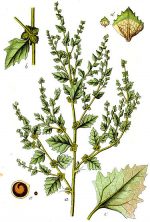 Also known as red orach, redscale, and tumbling orach this annual shrub is native to Eurasia but has been introduced to many areas including the US especially in the West. It is a member of the Amaranthaceae family that also includes spinach, beet, and celosia. Plants grow up to 4.5′ tall and have erect, hairless branching stems and green to red leaves with three prominent veins and a whitish mealy coating on at least the lower surface. Each leaf is 1-2.4″ long, oval to triangular to lanceolate, and has wavy to toothed margins. Axillary glomerules or interrupted terminal spikes of small inconspicuous female and male flowers appear on the same plant from mid summer to fall. The staminate flowers have a 5-parted perianth and are carried on the upper parts of the stems. The pistillate flowers lack a perianth and have 2 subtending bracts that are fused for less than half their length and have sharp projections on their sides. The fruit is a utricle containing brown to black seeds. Tumbling saltbush has been harvested from the wild for local use as a food, medicine and source of potash . The genus name, Atriplex, is the Greek name for orach, a related plant that can be used as spinach. The specific epithet, rosea, is the Latin word meaning rose-colored, and refers to the leaves.
Also known as red orach, redscale, and tumbling orach this annual shrub is native to Eurasia but has been introduced to many areas including the US especially in the West. It is a member of the Amaranthaceae family that also includes spinach, beet, and celosia. Plants grow up to 4.5′ tall and have erect, hairless branching stems and green to red leaves with three prominent veins and a whitish mealy coating on at least the lower surface. Each leaf is 1-2.4″ long, oval to triangular to lanceolate, and has wavy to toothed margins. Axillary glomerules or interrupted terminal spikes of small inconspicuous female and male flowers appear on the same plant from mid summer to fall. The staminate flowers have a 5-parted perianth and are carried on the upper parts of the stems. The pistillate flowers lack a perianth and have 2 subtending bracts that are fused for less than half their length and have sharp projections on their sides. The fruit is a utricle containing brown to black seeds. Tumbling saltbush has been harvested from the wild for local use as a food, medicine and source of potash . The genus name, Atriplex, is the Greek name for orach, a related plant that can be used as spinach. The specific epithet, rosea, is the Latin word meaning rose-colored, and refers to the leaves.
Type: Annual shrub
Outstanding Feature: Tolerance to lean, alkaline and saline soil
Form: Rounded
Growth Rate: Rapid
Bloom: Clusters of small inconspicuous male and female flowers on the same plant from mid summer into fall
Size: 4.5′ H
Light: Full sun
Soil: Average to lean, medium moist to dry, well-drained; tolerates saline and very alkaline soils.
Hardiness: Zones 2-9
Care :Low maintenance
Pests and Diseases: None of significance
Propagation: Seed
Outstanding Selections: None
Photo Credit: Wikipedia